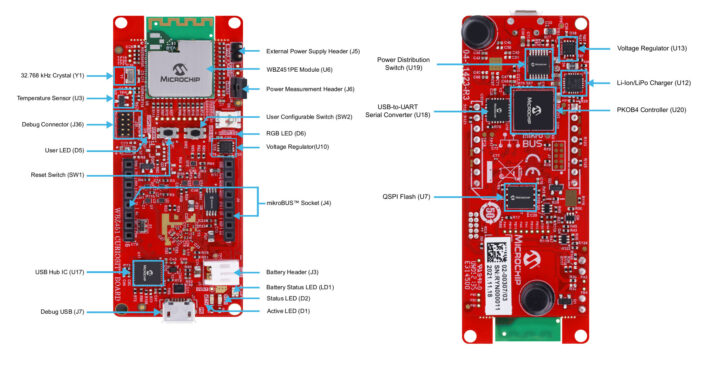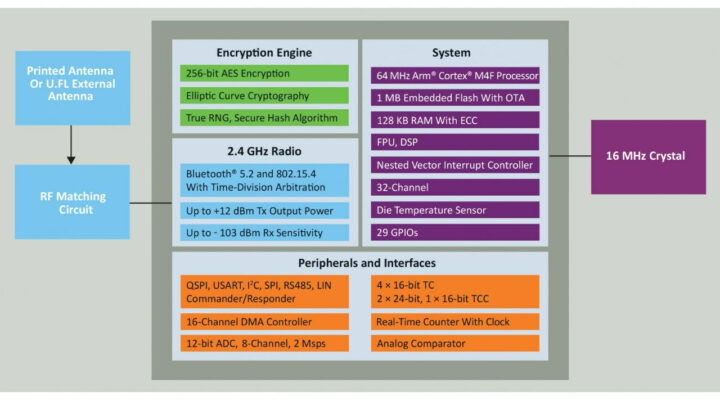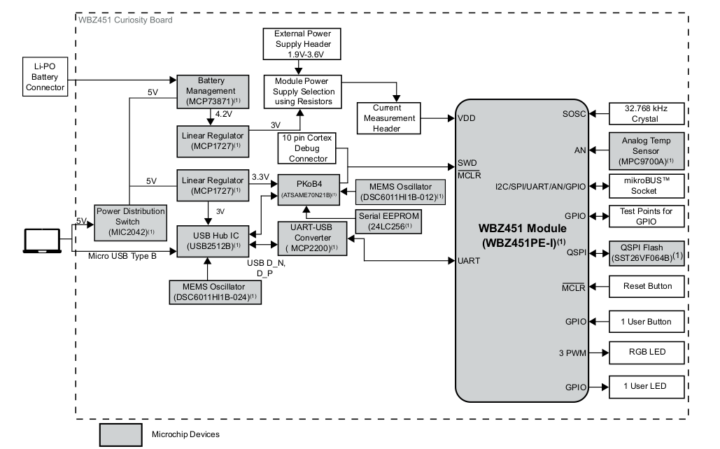Microchip WBZ451 Curiosity Board features the company’s Microchip’s WBZ451PE Bluetooth Low Energy 5.2 and Zigbee 3.0 RF module based on the new Microchip PIC32CX-BZ2 32-bit Arm Cortex-M4F wireless microcontroller.

WBZ451 Curiosity Board (EV96B94A) specifications:
- Wireless module – WBZ451PE Bluetooth Low Energy and Zigbee RF Module with
- Microchip PIC32CX-BZ2 32-bit Arm Cortex-M4F wireless microcontroller @ up to 64 MHz, 128KB RAM, 1MB flash, 2.4 GHz radio for Bluetooth LE 5.2 and 802.15.4 (Zigbee 3.0)
- Tx output power – Up +12 dBm
- Rx sensitivity – Up to -103 dBm
- PCB antenna
- 29x I/O pins
- Storage – 64Mbit QSPI flash
- Expansion – mikroBUS socket for MikroElectronika Click adapter boards
- Sensor – Microchip MCP9700A analog voltage temperature sensor
- Debugging
- On-board Programmer/Debug Circuit using PICkit On-board 4 (PKoB4) based on Microchip SAME70 MCU
- On-board USB to UART Serial Converter with Hardware Flow Control based on Microchip MCP2200
- 10-pin Arm Serial Wire Debug (SWD) header for external programmer/debugger
- Misc – Reset and user buttons, PWM RGB LED, user LED, 32.768 kHz Crystal
- Power Supply
- 5V via micro USB port
- 2-pin header for Li-Po Battery
- Microchip MCP73871 Li-Ion/LiPo Battery Charger with Power Path Management
- Power measurement header
- Power Consumption @ 3.3V
- Tx @ 0dBm with Buck Mode on @ 64 MHz, the PIC32XCBZ2 device draws 22.72 mA
- Tx @ +12 dBm Transmitter (Buck Mode @ 64 MHz) current consumption is 42.82 mA
- Tx @ +4 dBm Transmitter (Buck Mode @ 64 MHz) current consumption is 24.98 mA
- Dimensions – TBD


The WBZ451 Curiosity board ships with a USB to micro USB cable to get started, and software development tools include MPLAB Harmony 32-bit embedded software development framework and MPLAB Code Configurator, and some code samples can be found on GitHub together with documentation. You’ll also find the Getting Started instructions on Microchip’s documentation website.
The WBZ451 Curiosity Board can be used for wireless lighting, home automation or Internet of Things (IoT), industrial automation, and any Bluetooth Low Energy or Zigbee applications. The board sells for $67 directly on the Microchip website or through distributors. Further details may be found on the product pages for the board and microcontroller, as well as the press release.
Thanks to Magnus for the tip.

Jean-Luc started CNX Software in 2010 as a part-time endeavor, before quitting his job as a software engineering manager, and starting to write daily news, and reviews full time later in 2011.
Support CNX Software! Donate via cryptocurrencies, become a Patron on Patreon, or purchase goods on Amazon or Aliexpress




